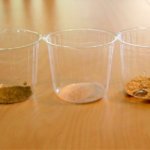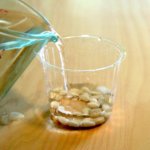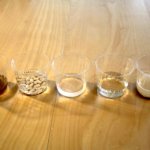Daily STREAM Activity: Dissolving Ingredients
Experiment in your kitchen!
Activity best for children age 2 and up
Have you ever sucked on a lollipop? What happens to the lollipop as you suck on it? Does it get smaller? Do you taste a flavor? That means it is dissolving in your mouth. When something dissolves that means that a solid (the hard lollipop) is mixing with a liquid (the salvia in your mouth) to make a solution (the tasty syrup in your mouth). Things that dissolve in water are called soluble, like sugar and salt. Things that do not dissolve in water are called insoluble, like oatmeal and pepper. This experiment will investigate which solids dissolve in water. Get ready to be a chemical engineer using ingredients from your kitchen!
Materials you’ll need:
Water
5-6 Clear containers
Spoons
Sugar, salt, pepper, beans, oatmeal, flour, dry noodles, sprinkles
Pen and paper for older kids
Guiding Questions:
What do you think will happen to the dry ingredients when you add the water?
Will they stay the same or change?
What happens if you add more water? Does it help to change the ingredient?
Do the ingredients need to be in the liquid longer? Shorter?
Directions
STEP 1
Find different ingredients in your pantry that you think will and won’t dissolve.

STEP 2
Put a spoonful of each test ingredient in its own clear container. Make a prediction before you add the water about which ingredient will dissolve in the water and which won’t.

STEP 3
Pour some water into each container, stir with a spoon and observe what happens. Make a prediction! What do you think will happen?
Was your prediction correct? Why do you think it dissolved or didn’t dissolve?

Grown ups, are you looking for more ways to extend your child’s learning? Check out these extension activities to build upon today’s STREAM activity!
Science Connection (age 6+)
Try the experiment again this time using warm and cold water. Does it speed up the process? Slow it down? Does it change the outcome of the experiment? Try using ingredients like seeds from fruits and veggies. Use sand and dirt. What happens if you use seltzer water (water with bubbles in it)? Does it take longer to dissolve ingredients?
Real World Connections
Make lemonade at home. When you stir in the sugar it dissolves into the water to help make your drink sweet.
Share your experiments with us on Instagram by tagging @sdcdm320!
Questions about this activity? Email education@sdcdm.org

